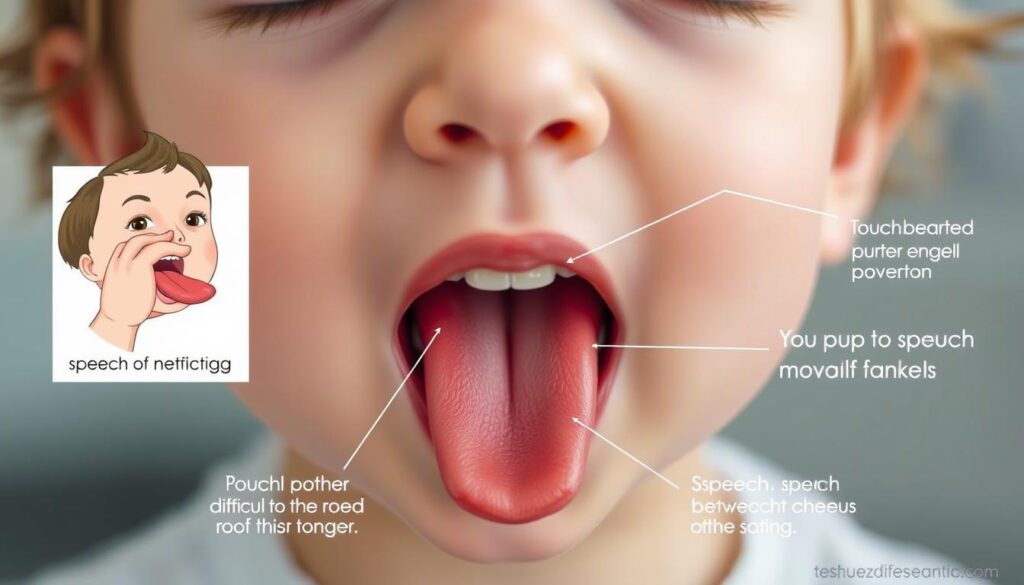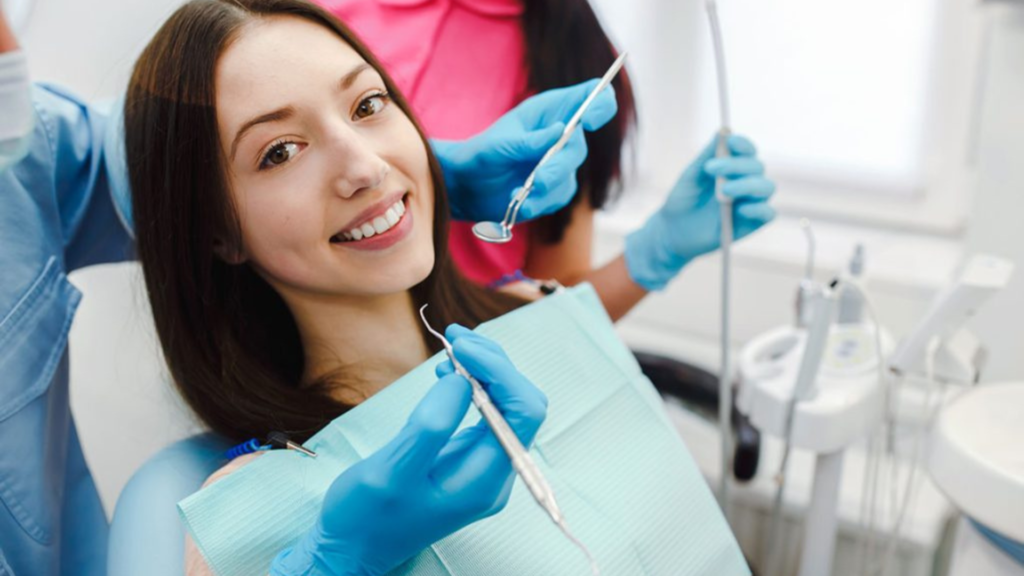A frenectomy is a simple surgery that removes or changes a frenulum. This is a small piece of tissue in the mouth. There are two main types: the lingual frenulum under the tongue and the labial frenulum between the lip and gum.
Frenectomies can help with speech, eating, and oral health. They address issues like tongue-tie, speech problems, orthodontic issues, and gum disease. The surgery can make things work better, prevent problems, and improve life quality for people of all ages.

Learning about frenectomy helps you make better choices for your mouth health. This article will cover the details of frenectomy. It will talk about the different types of oral frenums and the latest surgery methods. This will help you understand this key part of oral care.
What Is a Frenectomy and How Does It Work
A frenectomy is a surgery that removes or changes a frenulum. This is a small tissue fold in the mouth. It connects different parts of the mouth. The main types are the lingual frenulum (under the tongue) and the labial frenulum (lip to gum).
Types of Oral Frenums
Frenectomies fix different frenum problems, like:
- Lingual frenectomy – Fixes a tight or restricted lingual frenulum (tongue-tie)
- Labial frenectomy – Deals with a large or tight frenum between the lip and gum
- Buccal frenectomy – Releases tension in a frenum between the cheek and gum
Common Surgical Techniques
There are several ways to do a frenectomy, such as:
- Simple clipping or snipping of the frenulum
- Traditional surgery with sutures
- Z-plasty lengthening to release tension
Modern Laser Technology in Frenectomy
Laser technology has made frenectomies more precise and less invasive. CO2 laser and erbium:yttrium-aluminium-garnet (ER:YAG) laser frenectomies can be done without local anesthesia. This reduces pain and recovery time.

Signs You May Need a Frenectomy
If you or your child are experiencing any of the following signs, it may be time to consider a frenectomy procedure:
- Difficulty breastfeeding – Infants with tongue or lip ties can struggle to latch on or efficiently nurse, leading to weight loss, sore nipples, and pain for the mother.
- Speech impediments – A restricted frenulum can limit tongue movement, causing speech difficulties like lisping or trouble pronouncing certain sounds.
- Challenges with tongue movement – Tongue tie, also known as ankyloglossia, can restrict the range of motion for the tongue, making it difficult to eat, swallow, or maintain proper oral hygiene.
- Gaps between front teeth (diastema) – An overly-tight upper labial frenulum can cause a gap to form between the two front teeth.
- Gum recession – A short or tight labial frenulum can lead to gum recession, exposing more of the tooth structure.
- Difficulties managing saliva – Excess saliva production or drooling can indicate issues with the tongue’s mobility and frenulum restrictions.
- Increased lateral or forward mandibular movement – Tongue tie may cause the lower jaw to shift or protrude abnormally.
In some cases, frenulum restrictions can even contribute to dental caries (cavities) by limiting the tongue’s ability to help clean the teeth. Additionally, a heart-shaped tongue appearance may be a social consideration for some individuals.
If you or your child are experiencing any of these ankyloglossia symptoms or tongue-tie signs, it’s important to consult a healthcare professional to determine if a frenectomy could provide the necessary relief.

Different Types of Tongue and Lip Ties
Tongue and lip ties, also known as ankyloglossia and labial frenum issues, are common. They can make everyday tasks harder. These issues are based on how tight and where the tissue is.
Labial Frenum Problems
The labial frenum is a small piece of tissue that links the upper lip to the gums. If it’s too tight, it can cause gaps between teeth or gum loss. This might need a frenectomy to fix and improve your mouth’s health.
Lingual Frenum Restrictions
Ankyloglossia, or tongue-tie, happens when the lingual frenum is too short or tight. It can stop the tongue from moving freely. This makes eating, speaking, and brushing teeth hard. Studies show 5-20% of people might have tongue-tie.
Impact on Daily Activities
- It’s hard to breastfeed, causing pain or a bad latch for the mom.
- Eating solid foods is tough, like chewing and swallowing.
- It can also mess with speech, making sounds and words hard to say.
- Keeping the mouth clean is a struggle, leading to plaque and gum problems.
Spotting and treating tongue and lip ties early can help avoid these problems. Getting help from a healthcare expert is key to better function and life quality.

Benefits of Early Frenectomy Treatment
If you or your child have a tongue or lip tie, getting a frenectomy early can help a lot. This is especially true for kids around 6 years old. It can greatly affect their growth and health in the long run.
One big plus of early frenectomy treatment is it takes advantage of a fast growth period in the mouth. Fixing tongue or lip ties early lets the tongue move better. This improves eating, drinking, and talking. It also helps the palate grow right, which can prevent future dental problems.
For babies, a newborn frenectomy can fix breastfeeding issues. This leads to better feeding and weight gain. Adults can also benefit by avoiding speech problems, dental issues, and bad oral health.
In summary, getting a frenectomy early can greatly benefit a child’s infant oral surgery. It supports good mouth growth, speech, and overall health and happiness.
“Addressing tongue and lip ties early on can make a significant difference in a child’s growth, development, and quality of life.”
The Frenectomy Procedure: Step by Step Guide
If you or your child has trouble with breastfeeding, speech, or dental growth because of a tight frenulum, a frenectomy might help. This surgery fixes issues with the lip or tongue frenulum. It’s a simple process that can greatly improve your life.
Pre-Surgery Preparation
Your dentist will check you thoroughly before the surgery. They’ll talk about the surgery options, like traditional methods or laser technology. They’ll also discuss the benefits and risks to make sure you understand what’s happening.
During the Procedure
The frenectomy procedure usually takes under 15 minutes. A special laser, like the LightScalpel CO2 laser, is used to remove or change the frenulum. This method reduces bleeding and pain during the tongue-tie surgery or frenulum clipping.
Recovery Process
Right after the frenectomy procedure, you’ll start healing quickly. By the first week, half of the healing is done. By the three-week check-up, about 90% of the healing is complete. Your dentist might suggest gentle exercises to help with healing and prevent the frenum from attaching again.
It’s important to keep up with regular check-ups and talk to your dentist about any issues during recovery. This ensures the surgery is a success.
“The frenectomy procedure can be a life-changing solution for those struggling with breastfeeding, speech, or dental development issues. With the advancements in laser technology, the process is more comfortable and efficient than ever before.”
Recovery and Aftercare Guidelines
After a frenectomy, the healing time is usually short. You might feel numbness in your tongue tip, some soreness, and eating might be hard for a few days. It’s important to take good care of yourself to avoid infections and heal well.
To help you recover smoothly, here are some key guidelines:
- Pain Management: Use over-the-counter pain relievers like ibuprofen (Advil, Motrin) and acetaminophen (Tylenol) for pain. If the pain is too much, you might need more help.
- Bleeding Control: Some bleeding is normal. But if it’s too much, act fast to stop it and tell your healthcare provider.
- Stitches/Sutures: Dissolvable stitches usually fall out in about 5 days. Black-silk stitches might need to be removed later. Losing stitches early is usually okay unless you’re bleeding a lot or had bone grafting.
- Swelling Management: Swelling gets worse around day 3 and then goes down. Use ibuprofen, sleep with your head up, and ice packs to help.
Keeping your mouth clean and following a special diet are key for a good frenectomy recovery. Eat soft, cool foods and avoid spicy, hot, crunchy, or hard foods.
Going to your follow-up appointments is important. It helps your healthcare provider check on your healing and make sure you’re doing well. If you notice any problems like numbness that lasts too long, bleeding that won’t stop, bad smells, fevers, or a lot of pain, tell your provider right away.
By following these tongue-tie release aftercare tips, you can have a quick and easy recovery. This will help you get back to normal and feel better overall.
Impact on Speech and Feeding Development
A frenectomy can greatly improve speech and feeding. It helps with sounds like “s, z, t, d, l, r” by making the tongue more mobile. This is especially helpful for those who have trouble speaking.
For babies, a frenectomy can fix breastfeeding problems. It lets the tongue move better, making nursing easier. It also helps with saliva during eating and speaking.
Speech Improvement Outcomes
Studies show frenectomy can really help with speech. A study with 5 patients saw big improvements in tongue movement right after the surgery. A 5-year-old boy with speech and feeding issues got better almost instantly after the procedure.
Another 5-year-old boy with similar problems also got better after the surgery. A big study with 188 patients found those with more serious speech issues got the most help from frenulectomy.
Breastfeeding Benefits
A frenectomy can change breastfeeding for the better. It lets the tongue move more freely, making nursing easier. This can help babies gain weight better and make breastfeeding more enjoyable for both mom and baby.
Even with these benefits, some might need extra help. This could include speech therapy or orofacial myofunctional therapy to get the best results.
“Correcting tongue tie through surgery may enable children to experience a full range of tongue movements necessary for proper speech and articulation.”
Choosing the Right Healthcare Provider
Choosing the right healthcare provider is key when dealing with tongue ties, lip ties, or other oral restrictions. Frenectomy, the surgery to release these tight frenulums, can be done by many professionals. This includes general dentists, pediatric dentists, orthodontists, periodontists, oral surgeons, and ear, nose, and throat (ENT) specialists.
It’s vital to pick a frenectomy specialist or tongue-tie treatment provider with lots of experience. Look for those with advanced training and certifications in laser dentistry. Plainsboro Dental Services, for example, uses laser frenectomies to improve oral function and health.
Board-certified pediatric dentists are great for checking how tongue and lip ties affect infant feeding and growth. They have special training in infant feeding and oral motor assessments. This is especially helpful for breastfeeding challenges.
- Check the provider’s experience and expertise in frenectomies.
- See how they handle post-operative care and work with other healthcare professionals.
- Choose providers who understand the mouth-body connection and its effects on neuromuscular function.
Getting recommendations from pediatricians, lactation consultants, or feeding therapists can help find a good oral surgeon for your child. Also, look at patient reviews and online resources to help make your choice.
Before scheduling a frenectomy, ask lots of questions about the provider’s experience, methods, and protocols. This ensures you pick the best healthcare professional for your child’s needs.
Potential Risks and Complications
A frenectomy is usually safe, but there are risks and complications to know. You might feel numbness in your tongue tip, get infections, or feel pain and soreness. Bleeding and hematoma are also possible. These issues can be managed with good care and doctor visits.
Long-term Considerations
Children with mixed dentition might face risks like an open bite or tongue thrust. There’s also a chance the frenum could reattach if you skip exercises. Your provider will guide you on these.
Talking to your doctor about these risks is key. Follow their instructions closely to avoid problems. Being informed and proactive helps ensure a good outcome and recovery.
FAQ
What is a frenectomy and how does it work?
A frenectomy is a simple surgery that removes or changes a frenulum. A frenulum is a small tissue link in the mouth. There are two main types: the lingual frenulum under the tongue and the labial frenulum between the lip and gum.
Common surgery methods include clipping, traditional frenectomy, and laser-assisted procedures.
What are the common signs that may indicate the need for a frenectomy?
Signs that might mean you need a frenectomy include trouble breastfeeding, speech problems, and tongue movement issues. Gaps between teeth, gum recession, and trouble with saliva during speech or eating are also signs. Increased lateral or forward jaw movement can also be a sign.
What are the different types of tongue and lip ties?
Labial frenum issues can cause gaps between teeth or gum recession. Lingual frenum restrictions, or ankyloglossia, can limit tongue movement. These issues can make everyday activities like eating, speaking, and brushing teeth harder.
What are the benefits of early frenectomy treatment?
Early treatment, around age 6, can help with tongue positioning during growth. It can shape the palate and prevent orthodontic problems. It also helps the tongue adapt to the mouth, improving chewing, swallowing, and speech.
What happens during the frenectomy procedure?
The procedure starts with preparation and a discussion of the surgery method. During the surgery, the frenulum is clipped, removed, or altered. This can be done with traditional methods or laser technology.
The recovery is short, but you might feel some discomfort, bleeding, or swelling.
What are the potential risks and complications of a frenectomy?
Short-term side effects include numbness, infections, pain, soreness, bleeding, and swelling. Long-term risks include frenum reattachment if exercises are not done. There’s also a chance of developing an open bite or tongue thrust swallow.
How can frenectomy impact speech and feeding development?
Frenectomy can help with sounds like “s, z, t, d, l, r.” It can also solve breastfeeding issues by improving tongue movement. It helps manage saliva during speech and eating.
How do I choose the right healthcare provider for a frenectomy?
Many professionals can do frenectomies, like dentists, pediatric dentists, and oral surgeons. Choose based on their experience, techniques, and post-operative care approach.
Discover more trends:
- Reasons to Avoid Brushing for Longer Than Two Minutes
- The Ultimate Guide to Softball Hairstyles
- Scar Stretch Marks Removal – All You Need To Know!
- Tattoo Removal Before and After Results You Can Trust
- Follow us on Facebook
- Follow us on Pinterest





